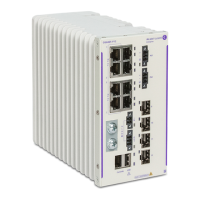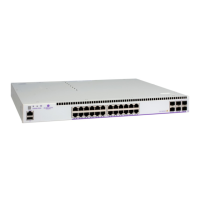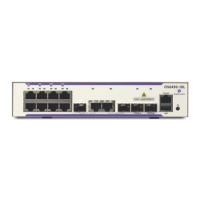PBB Features
Page 452 7210 SAS M Services Guide
traffic that needs to be circulated for two pass processing using the internal loopback.
NOTE: If only PBB Epipe is used (no I-VPLS service is configured for use), then egress
port mirroring can be enabled without affecting PBB traffic, since PBB Epipe traffic does
not use the two-pass approach.
• Multiple B-SAPs on the same port cannot be part of the same B-VPLS service. Two B-
SAPs on the same port need to be configured in two different services.
• Processing rules for packets received with multiple B-tags on a SAP:
→ If the B-Tag header has two tags, the packet is processed and forwarded appropriately
and sent out of an I-SID service or another B-VPLS B-SAP.
→ If the node is acting as a pure BCB (with no ISID/service termination), then the
packets are flooded and switched appropriately and if the node is acting as a BCB +
BEB, then the packets are flooded and switched appropriately on the B-SAPs, but they
will not switched or flooded to a I-SAPs (both VPLS and Epipe I-SAPs).
• PBB I-tag etype is not configurable, it is set to 0x88e7.
• PBB B-tag etype is not configurable; it is set to 0x8100.
• PBB packets received from a destination MAC address other than the one configured in
the epipe service is not accepted by 7210 devices.
• In the current release, PBB packets with UCA bit set are dropped.
• Aging of MAC addresses learnt in the B-domain - As long as a Customer MAC (C-MAC)
or an Epipe service is associated with an B-SA/B-MAC, do not age out the B-SA. When
the last customer MAC ages out or the last epipe service using the particular B-SA MAC
is removed, remove the corresponding B-SA entry. This means that as long as an epipe
service is associated with a particular PBB destination MAC address, the corresponding
B-MAC will not age out and will occupy an entry in the L2 learning table. Note, that if
only I-VPLS is in use, then aging out of C-MAC will automatically trigger aging out B-
MAC, when the last C-MAC associated with the B-MAC is aged out.
Configuration Guidelines (for 7210 SAS-M)
Listed below are the configuration guidelines specific to 7210 SAS-M devices configured in
Network mode:
When “discard-unknown” is enabled on a B-VPLS, the following behavior can be observed:
• Unknown unicast (B-DA) packets arriving on a B-SAP are dropped.
• Unknown unicast (C-DA) packets arriving on a B-SAP are processed normally in the I-
VPLS, if the B-DA is not unknown unicast.
• Unknown unicast (C-DA) packets arriving on an I-SAP are not dropped and are flooded in
the B-VPLS, because B-DA is equal to the “Group Mcast MAC” and is a known value
